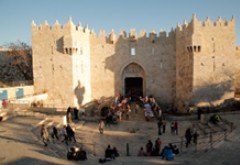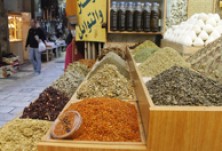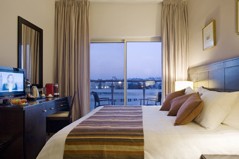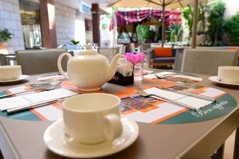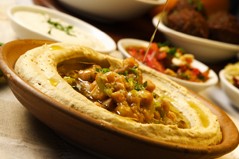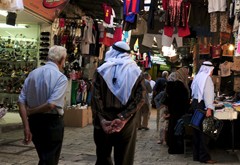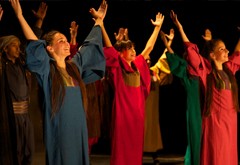The Mausoleum is located south of Jericho in a remote desert area with sparse vegetation, amid sand dunes, overlooking the Dead Sea. A number of motives were behind building the Mausoleum, most important of which was honoring Moses as one of the prophets mentioned in the Holy Quran, and because Muslims believe that their faith completes previous faiths (Christianity and Judaism), according to the Quranic verse: ‘‘The Messenger believeth in what hath been revealed to Him from His Lord, as do the men of faith; each one of them believeth in Allah, His angels, His books, and His messengers. We make no distinction, they say, between one and another of His messengers, and they say, we hear and we obey: We seek Thy forgiveness, our Lord, and to Thee is the end of all journeys’’. (al-Baqarah: 285). Building the Mausoleum in that area and in this size may be explained as a response to the desire to strike a balance with the group of monasteries established in the area since the Byzantine era.
Sponsors and Architecture
In spite of historical references indicating that the Prophet Moses festival started in the Ayyubid era, no architectural remains are attributed to that. The oldest available indications relate to the Mamluk Sultan Baybars era, who ordered the Mausoleum to be built in 1269 - 1270 AD (668 H). Baybarsis one of the establishers of the Mamluk state. He was a fighter and a firm administrator, and had architectural activities in Jerusalem, Palestine, and other areas of the Mamluk state, especially Cairo. Maintenance, renovation, and additions work at the Mausoleum never stopped between Baybars’ efforts and the British Mandate period (1917 - 1948), especially during the Ottoman period, by some people whose names were documented, but mostly by others who preferred to remain anonymous out of humility. Among those during the Ottoman period whose names we know are: Afaendi Husam al-Din (who was most likely the financier and the supervisor) in 1604 AD (1013 H), Shaikh Mohammad al-Khalili around 1726 AD (1139 H), and the Mufti of Jerusalem, Muhammad Taher al-Husseini in 1885 AD (1303 H).
Mausoleum’s Architectural Components
Architecturally, Nabi Mousa Mausoleum is considered the largest religious complex in Palestine after al-Masjid al-Aqsa, covering an area of about 5000 square meters and surrounded by a wall/fence. The compound comprises three floors and is entered through a door on the southern side, into a vestibule leading to an open central courtyard, with the five-bay mosque, Mausoleum, and water wells located in the middle. The courtyard is surrounded by over one hundred rooms and halls of different shapes and sizes. The compound also includes a stable in its basement, as well as corridors, storage, two bakeries, and two kitchens on the ground floor.
The compound has a minaret of medium height, but due to the topography of the area, it provides a spectacular view of the Jordanian mountain ranges. A large clearing to the south is used for shows and various activities during the festival period and as a parking space during normal days. To the east is a cemetery which is still used to bury those who feel blessed by the Mausoleum.
In addition to specific festival days when the place is very crowded, the compound attracts a number of local visitors and groups of Indian, Malaysian, and different regions from southeast Asia, as well as some Europeans, year round.
Festivals of the Mausoleum
Nabi Mousa had, and continues to have, one of the greatest and most famous festivals in Palestine. The festivities start on the Friday preceding the Greek Orthodox Good Friday, roughly between April 22 and 25, and continue for a period of one week. They can be summarized, as documented towards the end of the last century, as follows:
The Procession
The Festival started with residents of Jerusalem and curators of the Nabi Mousa Mausoleum congregating in al-Aqsa Mosque courtyard, then heading towards Jericho through Ras al-Amoud, passing through Via Dolorosa and Bab al-Asbat (St. Stephen Gate). City dwellers, especially those of Nablus and Hebron, and Jerusalem residents followed them in a procession with flags and banners, ornamented with Quranic verses and inscriptions depicting the names of the Righteous Caliphs and leaders of Sufism. dabka and zaffa (Palestinian wedding dances) troupes accompanied the procession, and people came by car and on horseback to the site. When the procession, especially numerous Sufi groups, arrived at the site, enthusiasm reached high levels, the tempo of drum beats accelerated, and special dances with sticks were performed as well as jousting with swords in perfect moves, accompanied by women eulogizing and spectators showing their appreciation.
Entering the Mausoleum, prayers, supplications, religious seminars, and recitation of the Quran were performed. People who attended were in the thousands, and tents had to be pitched around the compound, with new arrivals replacing departing ones. The festival was also a golden opportunity to fulfill promises, carry out circumcisions, and cut children’s hair for the first time. Free food was distributed to as many attendees as possible from the Mausoleum’s funds, as allocated for visitors. There was an abundance of services and food, to the extent that a special Halawa (candy) was developed for the occasion and named after the Mausoleum.
Celebrations continued for a whole week, until people started returning home on Thursday with the Three Banners’ Procession (Nabi Mousa, Nabi Daoud, and al-Aqsa Mosque banners). When the procession reached al-Aqsa Mosque, the banners were placed there in preparation for the next season.

